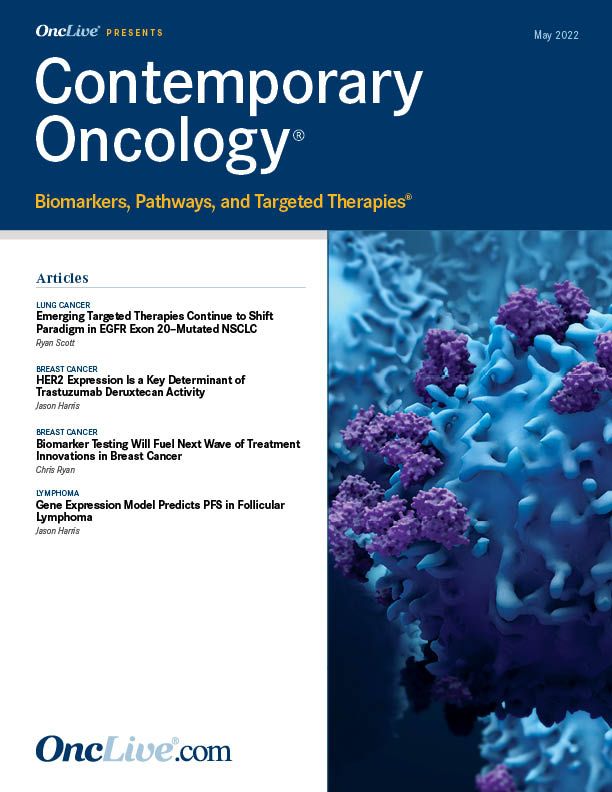Publication
Article
HER2 Expression Is a Key Determinant of Trastuzumab Deruxtecan Activity
Author(s):
HER2 expression appeared to be a significant predictor for response to fam-trastuzumab deruxtecan-nxki, according to findings from a biomarker analysis of patients with metastatic breast cancer in the phase 2 DAISY trial.

HER2 expression appeared to be a significant predictor for response to fam-trastuzumab deruxtecan-nxki (Enhertu), according to findings from a biomarker analysis of patients with metastatic breast cancer in the phase 2 DAISY trial (NCT04132960) presented during the European Society for Medical Oncology Breast Cancer Congress 2022.1
Investigators in DAISY assigned 186 patients with metastatic breast cancer to 1 of 3 cohorts based on HER2 immunohistochemistry (IHC) expression: IHC3+ or IHC2+/in situ hybridization (ISH)+ (cohort 1; n = 68); IHC2+/ISH- or IHC1+ (cohort 2; n = 72); and IHC0+ (cohort 3; n = 37). All patients received 5.4 mg/kg trastuzumab deruxtecan intravenously on day 1 of 21-day cycles.
Patients in cohort 1 were resistant to trastuzumab (Herceptin) and ado-trastuzumab emtansine (T-DM1; Kadcyla). Those in cohorts 2 and 3 were resistant to anthracyclines and taxanes, and to inhibitors of CDK4/6 inhibitors if they had hormone receptor–positive disease. Mosele noted that this population was heavily pretreated, with 53.1% of patients receiving at least 5 prior lines of treatment.
Best objective response (BOR) favored cohort 1 (71.0%; 95% CI, 58.3%-81.0%) compared with cohort 2 (37.5%; 95% CI, 26.4%-50.0%) and cohort 3 (30.0%; 95% CI, 16.0%-47.0%). Mosele added that the difference between the 3 groups was statistically significant (P < .0001).
“Antitumor activity [with trastuzumab deruxtecan] was associated with levels of HER2 [expression], even if we observe a 30% of response in the cohort of patients with no detection of HER2,” Maria Fernanda Mosele, MD, a clinical oncologist and translational researcher at Gustave Roussy Cancer Center in Villejuif, France, said in a presentation. “There was a moderate correlation between trastuzumab deruxtecan distribution and HER2 expression. A decrease in PD-L1 was observed only in the cohort of patients with HER2 overexpressing breast cancer.”
In an exploratory analysis, investigators sought to further explore the mechanism of action of trastuzumab deruxtecan through evaluation of the agent’s distribution, modulation of immune cells, and dynamic HER2 expression before and after administration. Additionally, investigators sought to develop predictors of response and identify mechanisms of primary and secondary resistance.
To conduct these analyses, tumor biopsy and whole blood samples of 5 mL were mandatory of all cohorts at baseline. Additional tumor biopsies were optional on days 2 and 4 of all cohorts with mandatory biopsy required between day 22 and 43 for patients in cohort one after cycle 1.
Ten paired samples at baseline and between days 2 and 4 were stained for trastuzumab deruxtecan distribution including 2 from cohort 1, 3 from cohort 2, and 5 from cohort 3. Distribution was lower in the cells that did not express HER2 compared with cells with higher HER2 expression.
Investigators assessed trastuzumab deruxtecan for modulation of immune cells. Among patients with HER2 IHC3+ or HER2 IHC2+/ISH+ disease (n = 18), Mosele and colleagues observed a significant decrease in PD-L1 expression (P = .002). She noted there was no such decline observed in patients with IHC1+ or IHC2+/ISH-negative (n = 10) or HER-IHC 0 (n = 3) disease.
In terms of secondary resistance, Mosele and colleagues used IHC to assess HER2 staining at baseline and at progression. Investigators noted that among 20 analyzed tumor samples, 65% (95% CI, 40.8%-84.6%) of patients demonstrated a decline in HER2 expression at progression.
She added that investigators are further assessing HER2 expression levels in baseline samples from patients in cohort 3 with no detection of HER2 by standard methods of immunohistochemistry. Trials assessing trastuzumab deruxtecan distribution at progression are also ongoing.
In findings first presented at the 2021 San Antonio Breast Cancer Symposium evaluating progression-free survival (PFS) by HER2 expression, investigators found that those in cohort 1 had the longest median PFS at 11.1 months (95% CI, 8.5-14.4) compared with 6.7 months (95% CI, 4.4-8.3) in cohort 2 (HR, 0.53; 95% CI, 0.34-0.84). In chort 3, the median PFS was 4.2 months compared with cohort 2 (HR, 1.96; 95% CI, 1.21-3.15).2
On May 4, the FDA approved trastuzumab deruxtecan for adults with unresectable or metastatic HER2-positive breast cancer who have previously received an anti-HER2–based regimen either in the metastatic setting, or in the neoadjuvant or adjuvant setting, and have developed disease recurrence during or within 6 months of therapy completion.
Data from the multicenter, open-label, DESTINY-Breast03 trial (NCT03529110) showed that trastuzumab deruxtecan improved median PFS compared with T-DM1 (not reached vs 6.8 months; HR, 0.28; 95% CI, 0.22-0.37; P < .0001).3
References
- Mosele F, Lusque A, Diéras V, et al. Unraveling the mechanism of action and resistance to trastuzumab deruxtecan (T-DXd): biomarker analyses from patients from DAISY trial. Presented at: European Society for Medical Oncology Breast Cancer Congress 2022. May 3-5, 2022; Berlin, Germany.
- Diéras V, Deluche E, Lusque A, et al. Trastuzumab deruxtecan (T-DXd) for advanced breast cancer patients (ABC), regardless HER2 status: a phase II study with biomarkers analysis (DAISY). Clin Cancer Res. 2022;82(suppl 4):PD8-02. doi:10.1158/1538-7445.SABCS21-PD8-02
- FDA grants regular approval to fam-trastuzumab deruxtecan-nxki for breast cancer. FDA. May 4, 2022. Accessed May 6, 2022. bit.ly/3ybhZLL









